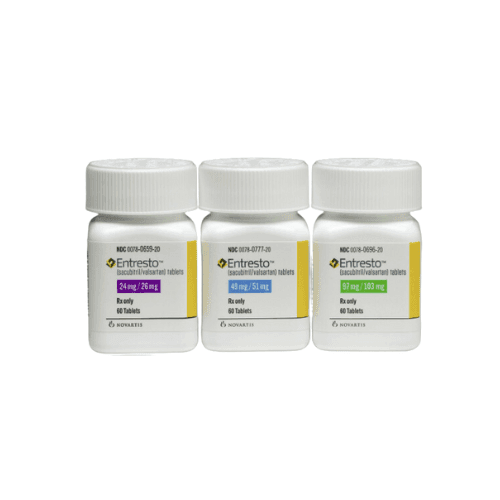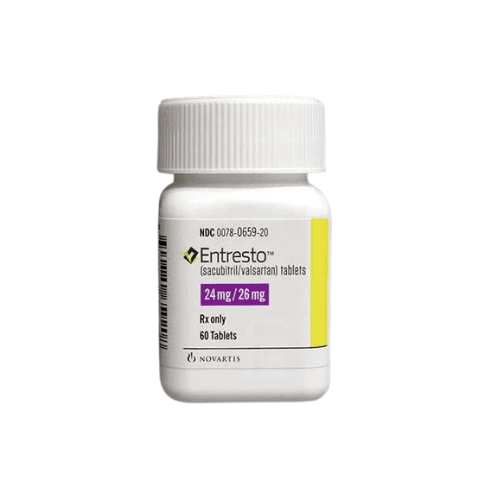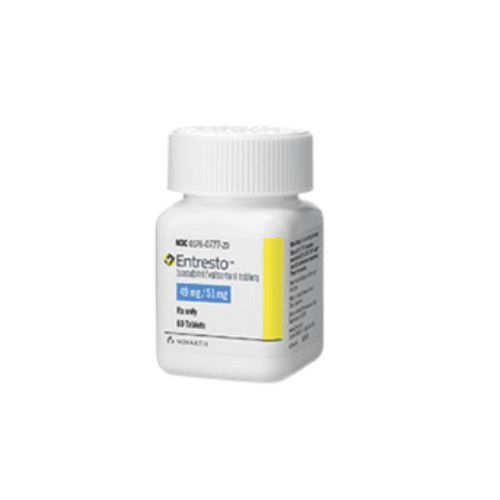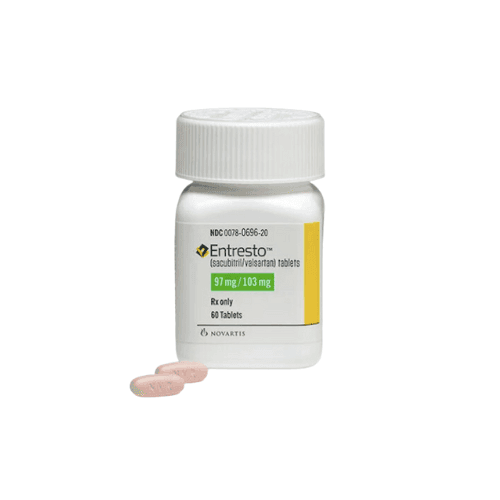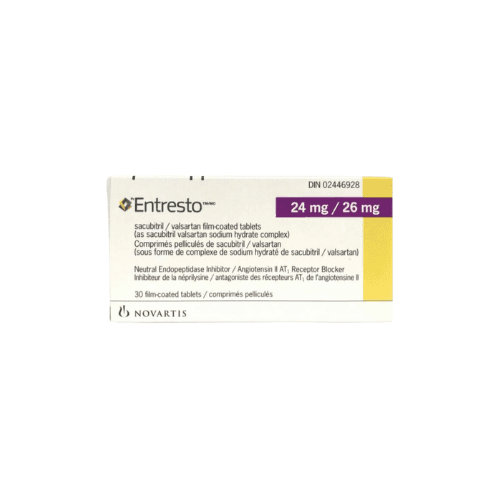Shipping with this method takes 3-5 days
Entresto® Tablets for Heart Failure with Reduced Ejection Fraction
Price range: $166.99 through $332.99
Secure Encrypted Payments
What Entresto® Is and How It Works
This prescription medicine combines a neprilysin inhibitor with an angiotensin receptor blocker. It helps reduce strain on the heart and supports better blood flow in people with chronic heart failure with reduced ejection fraction. This page explains usage, safety, and access details, including US shipping from Canada, and also notes options if you pay without insurance.
YouDrugstore is a licensed Canadian pharmacy in Manitoba. Pharmacists review prescriptions before dispensing.
Who It’s For
This therapy is indicated to reduce the risk of cardiovascular death and heart failure hospitalization in adults diagnosed with chronic HFrEF, typically NYHA class II to IV. It may be used in patients stabilized on other guideline-directed therapy when a prescriber considers a switch appropriate.
It should not be used during pregnancy. People with a history of angioedema related to ACE inhibitors or ARBs, those taking aliskiren with diabetes, or those with severe liver impairment should avoid it. A 36-hour washout is required when switching from an ACE inhibitor.
Learn more about the condition at Heart Failure and related care under Cardiovascular.
Dosage and Usage
The label describes twice-daily dosing of sacubitril valsartan tablets. The starting schedule depends on current or prior ACE inhibitor or ARB use, kidney and liver status, and blood pressure. A prescriber may adjust the dose after an initial period to reach the intended maintenance regimen.
Swallow tablets whole with water. Take with or without food, at the same times each day. If transitioning from an ACE inhibitor, wait at least 36 hours before the first dose. Do not combine with another ARB or with aliskiren in diabetes. Follow the official prescribing information if any uncertainty arises.
Patients often benefit from consistent routines. Pair dosing with daily habits, and set reminders to support adherence. Keep a log of blood pressure readings if instructed by your prescriber.
Strengths and Forms
Film-coated tablets are available as combinations of sacubitril/valsartan commonly published in labeling:
- 24/26 mg tablets
- 49/51 mg tablets
- 97/103 mg tablets
Color and shape vary by strength. Pack sizes and manufacturers’ packaging may differ by market. Availability can vary by location and supply.
Missed Dose and Timing
If a dose is missed, take the next dose at the regular time. Do not double up or take extra tablets to make up for a missed dose. Try to return to the set schedule as soon as practical.
Storage and Travel Basics
Store tablets at room temperature in a dry place. Keep them in the original container or blister until use. Protect from moisture and excessive heat. Keep out of reach of children and pets. When traveling, carry the labeled container and a copy of your prescription or a pharmacy receipt. A simple medication list can help at security checkpoints.
For trips with varied climates, use a small pill organizer and a sealable pouch for dryness. If you are flying, place tablets in your carry-on to avoid extreme temperatures in checked baggage.
Benefits
This treatment helps lower the risk of cardiovascular death and heart failure hospitalizations when used as directed. It supports heart function by reducing neurohormonal stress and easing vascular resistance. Many patients appreciate steady, twice-daily dosing with flexible administration relative to meals. Ongoing monitoring by a prescriber helps tailor therapy as part of a comprehensive heart failure plan.
Side Effects and Safety
- Headache or dizziness
- Cough
- Low blood pressure
- High potassium
- Kidney function changes
- Stomach discomfort
Angioedema is a serious and rare risk; seek emergency care if swelling of the face, lips, tongue, or throat occurs. Fetal toxicity can occur if taken during pregnancy; discontinue if pregnancy is detected. Kidney function and potassium may need monitoring. The risk of symptomatic low blood pressure may be higher with diuretics or dehydration.
Drug Interactions and Cautions
Avoid concurrent use with an ACE inhibitor; a 36-hour washout is required. Do not use with aliskiren in patients with diabetes. Combining with other ARBs is not recommended. Use caution with potassium-sparing diuretics, potassium supplements, or salt substitutes containing potassium. NSAIDs may affect kidney function, especially in those with impaired renal function or dehydration. Lithium levels can rise with ARBs; monitoring may be required. Discuss all medicines, vitamins, and herbs with your prescriber. For a broader overview, see Top Interactions.
What to Expect Over Time
Blood pressure may decrease, particularly as doses are adjusted. Symptoms such as shortness of breath or swelling may change as part of overall heart failure care. A prescriber may order lab checks and assess kidney function and potassium. Report any persistent dizziness, fainting, cough, or swelling. Consistent use and follow-up visits help evaluate benefit and safety over time.
Compare With Alternatives
Heart failure care often includes multiple therapies. SGLT2 inhibitors are commonly added in appropriate patients. Options we carry include Jardiance and Forxiga. Diuretics, beta blockers, and mineralocorticoid receptor antagonists may also be used according to guidelines and clinical judgment. Choice depends on symptoms, kidney function, blood pressure, and prior treatment. Discuss the plan with your healthcare professional.
Pricing and Access
We make cross-border access straightforward with Canadian pricing and clear checkout. Order Entresto from Canada is available, and fulfilment Ships from Canada to US with careful packaging. View current brand pricing, review options, and upload a valid prescription for pharmacist review. Encrypted checkout helps protect your information during payment.
Looking to manage costs? Ask your prescriber about multi-month fills when appropriate. You can also review our seasonal offers on Promotions from time to time.
Availability and Substitutions
Supply can vary by strength and pack size. If a specific tablet is unavailable, a prescriber may suggest a comparable alternative or adjust the plan. If you prefer a seamless online process, you can buy Entresto online after submitting your prescription and selecting the strength your prescriber recommends.
Patient Suitability and Cost-Saving Tips
This medicine suits many adults with HFrEF when blood pressure and labs are appropriate for therapy. It may not be a fit during pregnancy, in severe liver impairment, or after certain allergic reactions. Keep a list of all medicines, monitor for dizziness, and stay hydrated as advised by your prescriber.
To lower out-of-pocket spending, consider longer fills if stable on therapy, sign up for refill reminders, and compare brand pricing with any available substitutes your prescriber deems appropriate. Patients seeking lower costs sometimes look to buy generic sacubitril valsartan when supply and approvals allow.
Questions to Ask Your Clinician
- Is this treatment appropriate for my heart failure stage?
- How will this medicine fit with my current therapies?
- What labs should be monitored and how often?
- What signs of low blood pressure should I report?
- Could potassium or kidney function be affected in my case?
- How long should we assess response before any change?
Authoritative Sources
Manufacturer: NovartisFDA DailyMed Prescribing InformationHealth Canada Drug Product Database
Start a simple request with YouDrugstore for prompt US delivery from Canada; temperature-controlled handling when required. This information is not medical advice; follow your prescriber and the official label.
Express Shipping - from $25.00
Prices:
- Dry-Packed Products $25.00
- Cold-Packed Products $35.00
Shipping Countries:
- United States (all contiguous states**)
- Worldwide (excludes some countries***)
Standard Shipping - $15.00
Shipping with this method takes 5-10 days
Prices:
- Dry-Packed Products $15.00
- Not available for Cold-Packed products
Shipping Countries:
- United States (all contiguous states**)
- Worldwide (excludes some countries***)
How does this heart medicine work in heart failure?
It combines neprilysin inhibition with angiotensin receptor blockade. Together, these mechanisms can reduce neurohormonal stress and ease blood vessel resistance. Over time, that may support improved cardiac efficiency and reduce hospitalizations in people with chronic HFrEF. A clinician decides when this approach is appropriate and how it fits with other therapies such as beta blockers, diuretics, and SGLT2 inhibitors. Regular follow-up and lab checks help confirm safety and overall response.
Who should not take Entresto?
Avoid use during pregnancy. Do not take it within 36 hours of an ACE inhibitor. It is not recommended with another ARB or with aliskiren in diabetes. People with a history of angioedema related to ACE inhibitors or ARBs should not take it. Those with severe liver impairment may also be unsuitable. Always share your full medication list and medical history with a prescriber before starting this therapy.
What if I miss a dose?
If a dose is missed, take the next dose at the usual time. Do not double up to make up for a missed dose. Try to return to the regular schedule promptly. If missed doses occur frequently, ask your healthcare professional about tools such as reminders, blister packs, or a pill organizer to help maintain a steady routine.
Are there common side effects?
Common side effects include headache, dizziness, cough, low blood pressure, elevated potassium, kidney function changes, and stomach discomfort. Serious but rare angioedema can occur and needs urgent care if swelling affects the face, lips, tongue, or throat. Your prescriber may monitor blood pressure, electrolytes, and kidney function, especially after dose adjustments or if you take diuretics or NSAIDs.
Can I use it with my current blood pressure medicine?
Some combinations are appropriate and commonly used, while others are not. It should not be taken with ACE inhibitors, another ARB, or aliskiren in diabetes. Many patients also use beta blockers, diuretics, and mineralocorticoid receptor antagonists as part of guideline-directed therapy. Provide your full medication list to your prescriber for an individualized plan.
How is it stored and how do I travel with it?
Store tablets at room temperature in a dry place, ideally in the original container. Protect from moisture and excessive heat. Keep away from children and pets. When traveling, keep medicines in your carry-on bag and bring documentation such as a prescription label or receipt. A small organizer can help maintain your schedule across time zones. Avoid storing tablets in cars where temperatures can vary.
Is there an Entresto coupon or savings option?
Some patients use an Entresto coupon or compare Canadian pricing to reduce cash spending. Multi-month fills may also lower per-fill fees. Your prescriber can advise if longer supplies are suitable. Review our site for seasonal promotions, and compare brand costs with any approved substitutes your prescriber considers appropriate.
